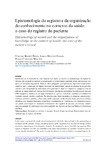Mostrar o rexistro simple do ítem
Epistemologia do registro e da organizaçâo do conhecimento no contexto da saúde: o caso do registro do paciente
| dc.contributor.author | Bentes Pinto, Virginia | es_ES |
| dc.contributor.author | Meneses Farias, Karla | es_ES |
| dc.contributor.author | Carvalho Meneses, Bruno | es_ES |
| dc.date.accessioned | 2013-11-29T11:05:57Z | |
| dc.date.available | 2013-11-29T11:05:57Z | |
| dc.date.issued | 2013 | es_ES |
| dc.identifier.citation | Actas del X Congreso de ISKO-España. Ferrol 20 de junio-1 de julio de 2011; 2013: 455-470. ISBN: 978-84-9749-535-6 | es_ES |
| dc.identifier.isbn | 978-84-9749-535-6 | es_ES |
| dc.identifier.uri | http://hdl.handle.net/2183/11630 | |
| dc.description.abstract | [Resumo] Apresentam-se os resultados de uma pesquisa cujo objeto de estudo é a epistemologia do registro do paciente, privilegiando os aspectos da organização do conhecimento registrado nesses documentos, com apoio nos elementos linguísticos. Partiu-se desta indagação: que aspectos da linguística textual podem contribuir para a construção de mapas conceituais de representação indexal de prontuários do paciente, visando a uma recuperação de informação com qualidade? O objetivo é mapear os sintagmas, a fim de elaborar um mapa conceitual referente às informações contidas nos prontuários. Identificaram-se cerca de 1000 sintagmas e construiu-se um mapa conceptual no software CmapTools, conforme os elementos da lingüística textual: coesão e coerência. No primeiro caso, foram mapeados os sintagmas concernentes à referência endofórica (anáfora, substituição, elisão conjunção, coesão lexical). Relativamente à coerência identificou-se o domínio lingüístico, pragmático e extralingüístico. Concluiu-se que a lingüística textual tem grande contribuição no tratamento informacional dos registros do paciente, pois oferece ?pistas? para a recuperação de informação com maior qualidade nos Serviços de Arquivos Médicos e Estatísticos (SAMEs). | es_ES |
| dc.description.abstract | [Abstract] In this paper, we present the results of an investigation in which the object of study is the epistemology of treatment and the patient?s record, containing aspects of the organization of recorded knowledge in these documents, supporting us in the linguistic elements. We attempted to answer the following question: What aspects of linguistic text that can contribute to the index representation of a patient's records in order to recover quality information? The goal is to map the phrases in order to build a conceptual map for the information contained in the records. It was identified more than 1000 phrases and it was built a concept map in the software CmapTools, according to the elements of textual linguistics, cohesion and coherence. In the first case, we mapped the phrases pertaining to endophoric references (anaphora, substitution, elision, conjunction, lexical cohesion). In relation to coherence it was identified the linguistic, pragmatic, and extra-linguistic domain. We conclude that the textual linguistics has great contribution in the informational treatment of patient records, therefore, offers "tracks" for information retrieval with more quality in the Medical Records and Statistics Services. | es_ES |
| dc.language.iso | por | es_ES |
| dc.publisher | Universidade da Coruña | es_ES |
| dc.subject | Patient's records | es_ES |
| dc.subject | Textual linguistics | es_ES |
| dc.subject | Concptual maps | es_ES |
| dc.subject | Indexing representation | es_ES |
| dc.subject | Epistemology of records health | es_ES |
| dc.subject | Prontuário do paciente | es_ES |
| dc.subject | Linguística textual | es_ES |
| dc.subject | Mapas conceituais | es_ES |
| dc.subject | Representação indexal | es_ES |
| dc.subject | Epistemologia do registro em Saúde | |
| dc.title | Epistemologia do registro e da organizaçâo do conhecimento no contexto da saúde: o caso do registro do paciente | es_ES |
| dc.title.alternative | Epistemology of record and the organization of knowledge in the context of health: the case of the patient?s record | es_ES |
| dc.type | info:eu-repo/semantics/conferenceObject | es_ES |
| dc.rights.access | info:eu-repo/semantics/openAccess | es_ES |






